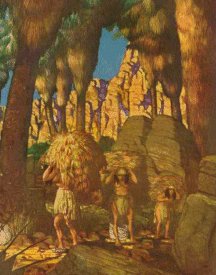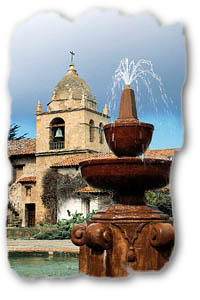Saint or
Sinner?
My understanding and appreciation of the life style of the Indians
of Southern California prior to the arrival of the Spanish explorers and clergy has
increased during the past fifty plus years of association with their descendants and
research of the records left by the explorers and pioneers.
Each of the various Indian peoples of Southern California contacted by the explorers,
clergy, and pioneers had the same basic needs as do all people throughout the world today,
and these same basic needs have been experienced by all people throughout all time periods
in the history of people. These basic needs include, but are not limited to, the need to
relate to the universe, the need for food, the need' to procreate, the need to belong to
and to be a part of a group, the need to love and be loved, the need for artistic
expression, the need to communicate, the need for shelter and clothing, and of course all
people have the same body function needs.
 That they were able to meet their basic needs and not
only survive but multiply in diverse and often harsh environments, indicates that the
early Indians of Southern California had intelligence, strength, endurance, resilience and
adaptability.
That they were able to meet their basic needs and not
only survive but multiply in diverse and often harsh environments, indicates that the
early Indians of Southern California had intelligence, strength, endurance, resilience and
adaptability.
The Southern California Indians met their need for food by using more than sixty
varieties of native plants for nutrition and probably an additional thirty for stimulants
or medicines. A great many animals and even some insects were also utilized as food. No
one had a monopoly on the food resources, and each individual participated in the
procurement and preparation of the plant and animal resources for meeting the basic human
need for food.
All people from the beginning of time to the present have searched for and developed a
relationship with the universe. People have sought a source of power greater than their
own. Both the methods of the search and the resulting beliefs or doctrines have been
diverse, but also there have been some similarities among all people in respect to the
great fundamental universal truths which nurture the continuation of the human species.
The Indians of Southern California, long before the arrival of the Spanish, had
developed cosmological concepts, value systems, a moiety system that regulated marriage,
and a cyclic food gathering system that supported an increasing population in apparently
reasonably good health. They had developed skills in providing necessary clothing and
shelter, and even among some populations practiced agriculture somewhat similar to that
practiced by the ancient Egyptians. Their communication skills we're adequate to meet
their needs, and their need for artistic expression was manifested in a variety of ways
during their daily activities.
In May, 1769, Don Miguel Costanso, who compiled the narrative of the Portola
Expedition, described the Indians of the San Diego area as being "well-built,
healthy, and active." Fr. Serra on July 3, 1769, wrote that the Indians of the San
Diego area were exceedingly numerous, lived well on various seeds and on fish obtained
from the sea, and that they were very friendly. Costanso made further comment about the
Indians while on the journey up the coast with Portola's party. He stated that the whole
country was inhabited by a large number of Indians who were very docile and tractable. Fr.
Crespi, in August, 1769, wrote of the Indians bringing abundant presents of seeds, acorns,
and pine-nuts for Portola's party.
Fr. Garces, a devoted priest and early explorer, described the Indians as being strong,
healthy, friendly, generous in sharing their food with him, and helpful in guiding him
across the desert. Garces was well treated by the many Indian groups he visited during his
two thousand mile journey over desert, mountain, and river lands in the southwest. He
wrote of the Mojaves along the Colorado River as being very superior and of taking
excellent care of him.
Descriptive terms of "great fishermen," "ingenious," "well
built," "good disposition," "agile," "alert,"
"diligent," "skillful," "peaceful," and "great
hunters" appear throughout the written accounts of the earliest explorers.
The decimation of the Indian population of Southern California began during the mission
period of California history and has been well documented. There were many causes for the
rapid decline, with perhaps health, nutrition and pressure from the aggressive
Spanish-Mexican culture being the most critical.
King Carlos III of Spain became alarmed upon learning of the Russian fur traders'
exploration and occupation of California north of San Francisco. Efforts to proceed with a
Spanish plan to colonize California resulted in what was termed a "Sacred
Expedition" composed of two divisions. The military division was under the command of
Captain Don Gasper de Portola, and the Roman Catholic Church division was under the
command of Father Junipero Serra. Spanish ships loaded with supplies were sent to meet and
supply the "Sacred Expedition" at San Diego. Here in 1769 the first of a series
of missions reaching from San Diego to San Francisco was established. Mission San Gabriel,
the fourth of the series, was established near Los Angeles in the San Gabriel Valley in
1771. The local Indians assisted in cutting the timbers, dragging the logs to the mission
site, and helping with the construction. The Indians of Southern California shared their
friendship and their food resources with the members of the "Sacred Expedition" who had been sent by the Spanish authorities to impose on all California Indians the rules
proposed as early as 1519 by the Franciscan bishop Rt. Rev. Juan de Quevedo, and practiced
at the Franciscan missions in Texas and Mexico. The essential features of these rules have
become known as the Mission System.
 The Mission System, as viewed by some of the Indians, meant not
only a complete change in the way they had learned to meet their basic needs, but absolute
slavery to an established hierarchy in all matters spiritual and temporal. Their previous
life style had provided more individual freedom.
The Mission System, as viewed by some of the Indians, meant not
only a complete change in the way they had learned to meet their basic needs, but absolute
slavery to an established hierarchy in all matters spiritual and temporal. Their previous
life style had provided more individual freedom.
The missionaries, according to Fr. Zephyrin Engelhardt, believed they had "encountered a race of people who did not reason, whose thoughts turned on nothing
higher than how to fill their stomachs without laboring to produce that which would
sustain life." The missionaries, because of a great communication gap due not only to
the language barrier, but also to the cultural barrier, believed it useless to begin the
work of converting the Indians to their religious beliefs by reasoning. They believed the
Indians had no idea of the creator and neither knew nor cared where they came from or
where they would go. So they treated the Indians as little children giving them presents
of trifles and food at first for any service rendered. The treatment in fact made the
Indians beggars, dependent upon the missionaries who were supported by military force.
The women and girls were soon collected and placed under a matron, and the men and boys
were used as laborers to farm the lands after the oak trees that had provided them with
food were cut and used as lumber to build the mission buildings. Those who could not
comply with the restrictions and ran away were pursued, captured and returned to the
mission for punishment. In fact some reports would indicate that expeditions were sent out
from the mission to capture the women and girls of Indian villages, knowing that the men
and boys would follow the expedition back to the mission to try to stay close to their
family members.
An early unfortunate event occurred at San Gabriel Mission soon after it was founded
that illustrates not only the lack of communication between the Indians and the Spanish
but also gives one example of the cruel punishment inflicted upon the Indians to induce
fear and thus compliance with the wishes of both the military and spiritual authorities.
One of the soldiers raped the wife of the chief of the village, and the chief, wanting to
punish the soldier, gathered some friends and with their bows and arrows attempted to get
close enough to release their arrows and inflict harm to the soldier. The soldier had a
leather jacket for protection from the arrows and used his gun to shoot the chief.
The shot frightened the Indians, who fled. It also alerted the other soldiers at the
mission who came and helped cut off the dead chief's head. This was placed on a pole which
was then taken to the Indian Rancheria to further frighten the Indians into submission.
Within a few days some of the Indians came to the mission and asked the missionary for the
head of the chief, which he gave to them. The fact that the soldiers who accompanied the
missionaries abused and mistreated the Indians was a constant problem and at times created
conflict between the church authorities and the military authorities.
Missionaries also inflicted punishments. Usually shackles, the lash and the stocks were
used when Indians failed to understand the obligations placed on them by the missionaries.
Such punishments were usually considered to be much like what a parent at that period of
time could use on his own children. The Indians who could not or would not conform to the
Mission System had the alternatives of fleeing from the missionaries or dying. At the San
Gabriel Mission the baptismal register for 1794 listed 2,552 baptisms and 1,181 deaths,
and in 1845, a total of 8,841 baptisms and 6,048 deaths. These records verify that there
were many who died.
On May 20, 1810, the venerable Franciscan Mission Priest Francisco Dumetz of the San
Gabriel Mission led a company of priests, soldiers and neophytes into the San Bernardino
Valley and conducted the first Christian worship among the Indian residents and others who
were gathered to observe the feast day of St. Bernardine of Siena. Accordingly, the priest
named the valley San Bernardino, a designation which later applied to the nearby mountain
range, a particular mountain, and eventually to both county and city.
The authorities of San Gabriel Mission wished to extend their influence over the
Indians of the San Bernardino mountains, the inland valleys, and the desert areas and
proceeded to establish an Asistencia, or branch of the San Gabriel Mission, in the San
Bernardino valley. An irrigation ditch was completed by the valley Indians under the
supervision of a Spanish majordomo in time for a planting of crops in 1820. More than
1,000 Indians responded to the mission invitation and many assisted with the necessary
work. A year later there were about 200 Indians still around the mission branch at San
Bernardino, and most of these had been baptized at the San Gabriel Mission.
Descendants of the San Bernardino Valley Indians have indicated that their people
became unhappy with the mission authorities because the food produced was taken to the San
Gabriel Mission, and they did not receive what they considered a proper share of the food
grown. This discontent continued and later led to hostility between the Indians and
authorities from the San Gabriel Mission.
The Mission System, as well as contact with the military personnel and settlers brought
from Mexico to occupy-the land, began the destruction of the Southern California Indians'
spiritual and economic way of life. This decline, not only of the "life style",
but of the Indian population, was accelerated after Mexico won its independence from
Spain, initiated the secularization decrees, and the missionaries were recalled from their
work in California.
The Spanish impact on the culture of the Indians of Southern California was not unique.
The history of all people throughout the world reflects cultural change because of contact
with other people. The Spanish mission system impact came quickly upon the Indians and was
harsh, demanding and unrelenting. Those who survived best and kept some of their old
culture were the larger population groups more distant from the mission locations and
therefore less affected by the destructive influences.
 Rupert Costo, a Cahuilla descendant of one of the groups less affected by the
Spanish mission system, was very much opposed to the plan of making Rev. Junipera Serra a
candidate for sainthood. Serra, a Spanish priest who died in 1784, was a pivotal force in
California's early history. After arriving in 1768 in what was San Diego, he directed a
group of Franciscan priests who established a chain of nine religious missions to convert
California Indians to Catholicism and made plans for eleven others which were completed
after his death.
Rupert Costo, a Cahuilla descendant of one of the groups less affected by the
Spanish mission system, was very much opposed to the plan of making Rev. Junipera Serra a
candidate for sainthood. Serra, a Spanish priest who died in 1784, was a pivotal force in
California's early history. After arriving in 1768 in what was San Diego, he directed a
group of Franciscan priests who established a chain of nine religious missions to convert
California Indians to Catholicism and made plans for eleven others which were completed
after his death.
Rupert Costo was among those who attended a conference in Phoenix, Arizona, in 1987,
where Pope John Paul II participated in a special event in his honor. After stating that
the time had come to go forward, forget past mistakes and work for the future, the pontiff
stated:
"One priest who deserves special mention among the missionaries is the beloved
Fray Junipero Serra, who traveled through Lower and Upper California. He had frequent
clashes with the civil authorities over the treatment of Indians. In 1773 he presented to
the Viceroy in Mexico City a Representacion, which is sometimes called a 'Bill of Rights'
for Indians. The Church had long been convinced of the need to protect them from
exploitation. Already in 1537, my predecessor Pope Paul III proclaimed the dignity and
rights of the native peoples of the Americas by insisting that they not be deprived of
their freedom or the possession of their property. (Pastoral Officium, May 29, 1537: DS
1495). In Spain the Dominican priest, Francisco de Vitoria, became the staunch advocate of
the rights of the Indians and formulated the basis for international law regarding the
rights of peoples..."
Rupert Costo took exception to these remarks because he believed Pope John Paul was
misinformed. Rupert stated that it was not Serra who presented the so-called Bill of
Indian Rights to the Viceroy of Mexico. It was Captain Juan Bautista de Anza. Serra had
agreed, but then proceeded to violate every point in the document.
It was in the same 16th century when Pope Paul III proclaimed the dignity and rights of
the native peoples of the Americas that Cortes committed genocide against the Mexican
Indians, stealing their gold to send to Spain and confiscating their properties. Rupert
Costo believed John Paul II was truly misinformed when he spoke in Arizona and had not
examined extensive evidence which had been presented regarding the California missions'
genocide against the Indians.
The Spanish mission period of California history only lasted for about -fifty years and
was followed by the Mexican Rancho period of twenty-five years before California became a
part of the United States.